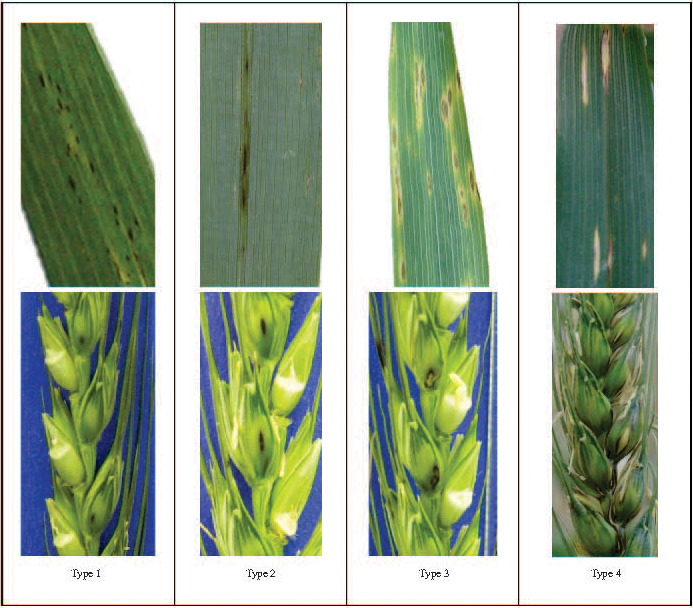Rosa Emilia Moraes, Scientific journalist at Linceu Editorial, São José dos Campos, SP, Brasil.
 Endemic in tropical and subtropical areas of the Brazilian Cerrado and Atlantic Forest, the wheat blast is caused by the fungus Magnaporthe oryzae Triticum (MoT). It was first reported in Brazil in 1985 and later registered in neighboring countries (KOHLI et al., 2011). For 30 years, it remained restricted to Latin America.
Endemic in tropical and subtropical areas of the Brazilian Cerrado and Atlantic Forest, the wheat blast is caused by the fungus Magnaporthe oryzae Triticum (MoT). It was first reported in Brazil in 1985 and later registered in neighboring countries (KOHLI et al., 2011). For 30 years, it remained restricted to Latin America.
However, recent disease outbreaks have occurred in other regions, such as Asia and Africa, where the climate is similar to that of the biomes where the blast was originally identified (DUVEILLER et al., 2016). The low effectiveness of combating MoT with the use of fungicides, observed in Paraguay, Bolivia and Argentina outbreaks, causes great global concern, given the significant role of this cereal as a staple food in several parts of the world.

Image: Gisele Abigail Montan Torres.
Figure 1. Types 1, 2, 3, and 4 of lesions in leaves and spikes of wheat (Triticum aestivum) inoculated with Magnaporthe oryzae Triticum.
In the review article Blast disease and wheat production in Brazil published in the journal Pesquisa Agropecuária Brasileira (vol. 57), researchers from the Empresa Brasileira de Pesquisa Agropecuária – EMBRAPA (Brazilian Agricultural Research Corporation) provide a brief historical context of wheat cultivation, the economic relevance and impacts of wheat production on global nutritional security, focusing the analysis on the Brazilian scenario that presents itself in 2022 and pointing out potential measures to enhance crop productivity in the regions affected by the MoT.
Brazil concentrates the largest volume of studies, research and literature on head blast since the disease is not a potential threat but an inherent challenge to wheat cultivation. The results of these studies guide the management of cultivars by reducing production vulnerability through biotechnology strategies that combine chemical control with the increase of genetic resistance, aiming to minimize production losses – which can reach 100% in more susceptible varieties.
Brazil’s experience in combating wheat blast disease can guide the measures to deal with outbreaks in other parts of the world, whose episodes are more recent. The review presented includes analyses of products and techniques currently available for disease control management. It also brings a panel of cultivars less vulnerable to MoT, including that without the 2NS translocation.
References
DUVEILLER, E., HE, X. and SINGH, P.K. Wheat blast: an emerging disease in South America potentially threatening wheat production. In: BONJEAN, A.P., ANGUS, W.J. and VAN GINKEL, M. (ed.) The World Wheat Book. Paris: Lavoisier, 2016.
KOHLI, M.M., et al. Pyricularia blast – a threat to wheat cultivation. Czech Journal of Genetics and Plant Breeding [online]. 2011, vol. 47, pp. S130-S134 [viewed 1 December 2022]. https://doi.org/10.17221/3267-CJGPB. Available from: https://www.agriculturejournals.cz/web/cjgpb.htm?volume=47&firstPage=S130&type=publishedArticle
To read the article, access
TORRES, Gisele Abigail Montan et al. Blast disease and wheat production in Brazil. Pesquisa Agropecuária Brasileira [online]. 2022, vol. 57, e02487 [viewed 1 December 2022]. https://doi.org/10.1590/S1678-3921.pab2022.v57.02487. Available from: https://www.scielo.br/j/pab/a/GfBqSnSYY6L3dGwjVBj98cD/
Links externos
Pesquisa Agropecuária Brasileira (PAB): www.embrapa.br/pab
Pesquisa Agropecuária Brasileira – PAB: http://www.scielo.br/pab
Como citar este post [ISO 690/2010]:

















Recent Comments